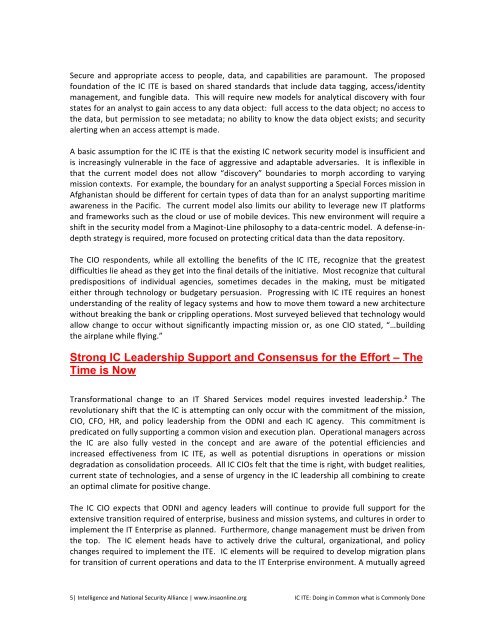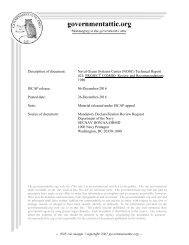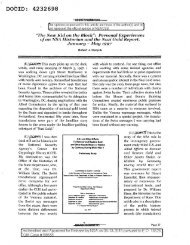insa-ic-ite
insa-ic-ite
insa-ic-ite
Create successful ePaper yourself
Turn your PDF publications into a flip-book with our unique Google optimized e-Paper software.
Secure and appropriate access to people, data, and capabilities are paramount. The proposed <br />
foundation of the IC ITE is based on shared standards that include data tagging, access/identity <br />
management, and fungible data. This will require new models for analyt<strong>ic</strong>al discovery with four <br />
states for an analyst to gain access to any data object: full access to the data object; no access to <br />
the data, but permission to see metadata; no ability to know the data object exists; and security <br />
alerting when an access attempt is made. <br />
A bas<strong>ic</strong> assumption for the IC ITE is that the existing IC network security model is insuff<strong>ic</strong>ient and <br />
is increasingly vulnerable in the face of aggressive and adaptable adversaries. It is inflexible in <br />
that the current model does not allow “discovery” boundaries to morph according to varying <br />
mission contexts. For example, the boundary for an analyst supporting a Special Forces mission in <br />
Afghanistan should be different for certain types of data than for an analyst supporting maritime <br />
awareness in the Pacif<strong>ic</strong>. The current model also limits our ability to leverage new IT platforms <br />
and frameworks such as the cloud or use of mobile dev<strong>ic</strong>es. This new environment will require a <br />
shift in the security model from a Maginot-‐Line philosophy to a data-‐centr<strong>ic</strong> model. A defense-‐in-depth<br />
strategy is required, more focused on protecting crit<strong>ic</strong>al data than the data repository. <br />
The CIO respondents, while all extolling the benefits of the IC ITE, recognize that the greatest <br />
diff<strong>ic</strong>ulties lie ahead as they get into the final details of the initiative. Most recognize that cultural <br />
predispositions of individual agencies, sometimes decades in the making, must be mitigated <br />
either through technology or budgetary persuasion. Progressing with IC ITE requires an honest <br />
understanding of the reality of legacy systems and how to move them toward a new arch<strong>ite</strong>cture <br />
without breaking the bank or crippling operations. Most surveyed believed that technology would <br />
allow change to occur without signif<strong>ic</strong>antly impacting mission or, as one CIO stated, “…building <br />
the airplane while flying.” <br />
Strong IC Leadership Support and Consensus for the Effort – The<br />
Time is Now<br />
Transformational change to an IT Shared Serv<strong>ic</strong>es model requires invested leadership.² The <br />
revolutionary shift that the IC is attempting can only occur with the commitment of the mission, <br />
CIO, CFO, HR, and pol<strong>ic</strong>y leadership from the ODNI and each IC agency. This commitment is <br />
pred<strong>ic</strong>ated on fully supporting a common vision and execution plan. Operational managers across <br />
the IC are also fully vested in the concept and are aware of the potential eff<strong>ic</strong>iencies and <br />
increased effectiveness from IC ITE, as well as potential disruptions in operations or mission <br />
degradation as consolidation proceeds. All IC CIOs felt that the time is right, with budget realities, <br />
current state of technologies, and a sense of urgency in the IC leadership all combining to create <br />
an optimal climate for positive change. <br />
The IC CIO expects that ODNI and agency leaders will continue to provide full support for the <br />
extensive transition required of enterprise, business and mission systems, and cultures in order to <br />
implement the IT Enterprise as planned. Furthermore, change management must be driven from <br />
the top. The IC element heads have to actively drive the cultural, organizational, and pol<strong>ic</strong>y <br />
changes required to implement the ITE. IC elements will be required to develop migration plans <br />
for transition of current operations and data to the IT Enterprise environment. A mutually agreed <br />
5| Intelligence and National Security Alliance | www.<strong>insa</strong>online.org IC ITE: Doing in Common what is Commonly Done
















